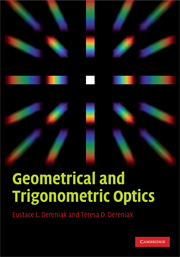Book contents
- Frontmatter
- Contents
- Preface
- 1 Light propagation
- 2 Reflections and refractions at optical surfaces
- 3 Image formation
- 4 Mirrors and prisms
- 5 Curved optical surfaces
- 6 Thin lenses
- 7 Thick lenses
- 8 Mirrors
- 9 Optical apertures
- 10 Paraxial ray tracing
- 11 Aberrations in optical systems
- 12 Real ray tracing
- Appendix A Linear prism dispersion design
- Appendix B Linear mixing model
- Appendix C Nature's optical phenomena
- Appendix D Nomenclature for equations
- Appendix E Fundamental physical constants and trigonometric identities
- Glossary
- Index
- References
11 - Aberrations in optical systems
Published online by Cambridge University Press: 06 July 2010
- Frontmatter
- Contents
- Preface
- 1 Light propagation
- 2 Reflections and refractions at optical surfaces
- 3 Image formation
- 4 Mirrors and prisms
- 5 Curved optical surfaces
- 6 Thin lenses
- 7 Thick lenses
- 8 Mirrors
- 9 Optical apertures
- 10 Paraxial ray tracing
- 11 Aberrations in optical systems
- 12 Real ray tracing
- Appendix A Linear prism dispersion design
- Appendix B Linear mixing model
- Appendix C Nature's optical phenomena
- Appendix D Nomenclature for equations
- Appendix E Fundamental physical constants and trigonometric identities
- Glossary
- Index
- References
Summary
Our tour through paraxial optics has only considered perfect images of scenes in which a point source in object space was mapped to a point in image space using paraxial rays. Gaussian optics also produced perfect images outside the paraxial region. Paraxial optics, however, is only a first-order approximation to a real optical system. Realizable optical systems do not produce perfect point images from point sources (represented mathematically as a delta function). In real optical systems, there is some blur or spreading of the point image.
Diffraction
The complex propagation of light passing through an aperture stop of a lens system will form a less than perfect image (for a detailed explanation of Huygens' wavefronts and propagation see Mahajan (2001)). In fact, the best one can do is to make the system “diffraction-limited.” Diffraction occurs when a wavefront (radiant beam) impinges upon the edge of an opaque screen or aperture. Light appears outside the perfect geometrical shadow because the light has been diffracted by the edge of the aperture. The effect this has on our simple rotationally symmetric optical systems is that a point does not map to a point, but is blurred or smeared. You may have observed the effect of the diffraction of light from a portal where there is light beyond what would be defined as the geometrical shadow boundary. If a wavefront, as shown in Figure 11.1, passes through a circular aperture, it does not continue as a circular disc.
- Type
- Chapter
- Information
- Geometrical and Trigonometric Optics , pp. 292 - 327Publisher: Cambridge University PressPrint publication year: 2008
References
- 1
- Cited by

